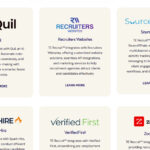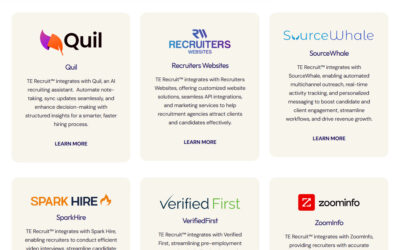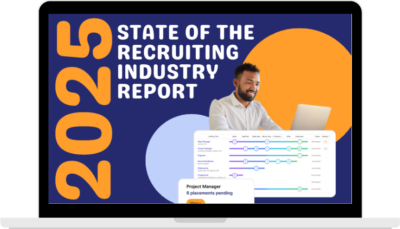(Editor’s note: The information from this article by Top Echelon Recruiting Software has been taken from an Expert Recruiter Coaching Series webinar by Rob Mosley of Next Level Coaching titled, “Get Inside Your Client’s Head: Understanding the Client Decision Process.” Click HERE to watch the video of that training webinar for free.)
In the world of recruiting and staffing, we often focus obsessively on our own process — intake calls, candidate sourcing, interviews, submittals, follow-ups, close. However, according to Rob Mosley, that internal focus may be costing recruiters business.
“We’re so focused on our own process,” said Mosley, partner at Next Level Exchange and international facilitator with the Aclavis Corporation, “that we forget to step back and ask where the client is in their process — their decision-making process.”
Mosley wants to “flip the script” for recruiters, shifting the focus from our own goals to our clients’ internal reality. Because if we don’t understand how our clients think, decide, and prioritize — we can’t influence them.
And influence is everything.
The Mindset Shift: From Process-Driven to Client-Centric
The core message of the session was about alignment. We must align with the client’s internal buying and decision journey, not just march forward with our own methodology.
“This session challenges the industry paradigm,” Mosley explained. “It’s not about pushing our process — it’s about understanding their process, and what value looks like to them at each stage.”
This is more than a sales strategy — it’s a mindset. It’s about adopting a position of curiosity, humility, and adaptability. “We can’t just survive change,” Mosley added. “We have to thrive in it.”
The recruiting environment is evolving fast. Clients are under pressure. Trust is scarce. Value is scrutinized.
Which brings us to a critical question:
Why should clients trust you?
Trust Isn’t Given — It’s Earned Through Behavior
At the heart of the decision process is trust. And trust isn’t just about being honest. It’s about how we show up — our competence, our conviction, and our mindset.
“When you looked in the mirror this morning,” Mosley said, “the degree to which you felt trustworthy in that moment affects everything — your personal relationships, your team, your clients. Trust rolls downhill.”
He pointed to high-profile trust breaches — Wells Fargo, Takata airbags, the UCLA admissions scandal — as examples of what happens when organizations violate trust at scale. But recruiters aren’t immune.
“Let’s not pretend we’re off the hook,” Mosley said. “Where do you think the phrase ‘all you recruiters are just alike’ comes from?”
To become more trusted — more legitimate — Mosley encouraged recruiters to operate from principles, not just tactics. Because, as he put it, “principles are where what’s smart in our industry meets what’s right in our industry.”
Four Foundational Principles for Recruiters
Here are four timeless principles that guide the recruiter-client relationship, according to Mosley:
-
Diagnosis Before Prescription
“If we offer solutions before understanding goals, motivations, problems, and needs — that’s consulting malpractice.”You wouldn’t want a doctor writing prescriptions without an exam. The same applies here.
-
Greater Awareness
If you don’t know where the client is in their decision process, you can’t align with them. And if you’re out of sync, you lose influence. -
Short-Term Behavior = Long-Term Consequences
Every email, call, or meeting shapes your brand. You’re either building trust — or eroding it. -
Differentiate by Approach — Not Price
“If you fail to differentiate by your approach, you’ll be forced to differentiate by your price. And that’s a game nobody wants to play.”
These principles serve as a compass. And when applied, they help us ask better questions — which is where Mosley believes the real magic lies.
Trick-or-Treating with Strategy: A Lesson in Potential, Probability, and Time
To illustrate the power of preparation, Mosley shared a story from childhood — dressed in a homemade Batman costume, he set out with a group of older kids to score the biggest candy haul in the neighborhood.
“I had the potential — there were tons of houses. I had the probability — I was with the seven-year-olds. But I had a time limit — mom’s curfew.”
So how did young Rob strategize?
“I looked for houses with lights on — signs of activity, opportunity. I didn’t just knock randomly.”
This, he explained, is what we should be doing with clients. Too often, we chase leads or pitch without taking the time to evaluate opportunity.
We must learn to illuminate the situation — to assess the window of sales opportunity.
The Window of Sales: Ask These Questions Every Time
Mosley laid out five diagnostic areas recruiters should probe to truly understand where a client is in their decision process:
-
Goals & Objectives
What’s the business trying to accomplish? -
Problems & Challenges
What stands in the way of achieving those goals? -
Needs
What do they believe they need — internally or externally — to solve those problems? -
Financial Factors
What budget, salary, or rate constraints are in play? -
Decision Process & Options
Who decides? What are their alternatives — competitors, internal teams, doing nothing?
“Don’t show up asking, ‘Do you have any hiring needs today?’” Mosley warned. “That’s not a consultative conversation — that’s a vendor question.”
Instead, use these questions to spark insight — and show that you understand their world.
The Eight Stages of Client Decision-Making
At the core of Mosley’s framework is the Eight Stages of the Client Decision Process — a model that reveals how clients make high-risk, high-value decisions (like hiring, partnering, or staffing).
“Every client goes through these stages — sometimes quickly, sometimes slowly,” he said. “And they do it with or without you.”
Let’s break them down:
-
Business Goals & Objectives
Companies start with mission-critical goals — growth, expansion, profitability. Everything flows from here. -
Problems & Challenges
Every meaningful goal brings obstacles — regulatory, competitive, cultural, or staffing-related. -
Needs Assessment
Only after identifying goals and obstacles do clients begin to articulate needs. But too many recruiters start here. -
Option Exploration
Clients explore all possibilities — other vendors, internal options, or doing nothing. -
Selection
They narrow the list. RFPs go out. Preferred partners are chosen. -
Commitment & Contract
Negotiations happen. Legal reviews terms. This is where many recruiters push hardest — but influence is already waning. -
Implementation
This is your search process — sourcing, screening, interviewing, onboarding. -
Measurement & ROI
Clients evaluate success. Did it work? Was it worth it? Would they do it again?
“Most recruiters only play in stages 3 to 6,” Mosley said. “We show up at the need. We pitch. We negotiate. And then we’re gone.”
But the real opportunity lies in stages 1, 2, 7, and 8 — where clients struggle most.
Bars of Pain: Where Clients Need You Most
Mosley introduced the concept of Bars of Pain — a visualization of where clients experience the most difficulty in the decision process.
The biggest pain points?
-
Stage 1: Setting goals
-
Stage 2: Navigating problems
-
Stage 7: Implementing effectively
-
Stage 8: Measuring results
“And guess where you add the most value?” Mosley asked. “Right where the client has the most pain.”
Yet as an industry, we tend to avoid these areas — because they’re messier, less transactional, more relational. But they’re also where long-term partnerships are born.
From Vendor to Value-Creating Partner
Where you engage in the process shapes how the client sees you. Mosley outlined three archetypes:
-
Vendor
“The dictionary definition includes hawker, peddler, huckster,” Mosley said. “And the example? The guy who sells peanuts at the ballpark.”
Vendors are order-takers. They show up too late to influence and compete only on price.
-
Supplier/Provider
These recruiters have a strong process and understand client pain, but still operate at arm’s length. -
Value-Creating Partner
These are true consultants. They engage early, align with goals, solve problems, and drive results.
“You don’t need all your clients to be value-creating partnerships,” Mosley noted. “That’s a lot of work. But a few can change your business.”
He encouraged recruiters to audit their accounts and categorize them honestly. From there, the goal is to elevate relationships — from vendor to provider, and eventually, to partner.
Inside the Loop: Where Influence Lives
Finally, Mosley reframed the decision process not as a line, but a loop.
“Most recruiters operate outside the loop,” he said. “They show up when the need is defined and the budget is set. There’s no room to influence.”
But inside the loop — at stages 1, 2, 7, and 8 — is where insight and influence live.
And they go together.
“Insight and influence always swim upstream or downstream together,” Mosley explained. “If you don’t have insight, you can’t have influence. And you can’t influence what you don’t understand.”
To get inside the loop, you must earn trust — by asking better questions, bringing value earlier, and staying engaged longer.
Your Playbook: What to Do Next
To apply this framework, Mosley recommended creating a Client Decision Playbook. For each stage of the process, document:
-
What questions can I ask?
-
What insight can I offer?
-
What pain can I help relieve?
-
What evidence can I share?
“Think of every best practice you’ve learned this year,” Mosley said. “Every play you’ve been taught — they all belong somewhere in this process. Build your playbook.”
And finally, remember this mantra:
“Clients will go through this process with or without you. Wouldn’t it be better if you came along for the ride?”
Final Thoughts: Elevate, Don’t Chase
This wasn’t a webinar about being slicker in your pitch or faster on the phones. It was a call to elevate how we think.
-
Don’t chase needs. Understand goals.
-
Don’t pitch solutions. Diagnose problems.
-
Don’t sell placements. Create partnerships.
Because when you get inside your client’s head — when you align with their journey — you stop being a vendor and start being indispensable.
And in today’s crowded market, that’s how you win.
Your Next Steps
✅ Evaluate your current accounts: vendor, provider, or partner?
✅ Develop probing questions for each of the 8 decision stages.
✅ Identify where you typically enter the process — and how to enter earlier.
✅ Build your Client Decision Playbook.
✅ Seek insight. Earn influence. Stay inside the loop.
As Rob Mosley said, “No one sees the world as it is. We see the world as we are. And our clients are no different. It’s our job to understand their world — and help them make the best decisions in it.”









